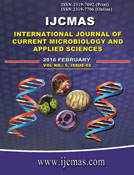


 National Academy of Agricultural Sciences (NAAS)
National Academy of Agricultural Sciences (NAAS)

|
PRINT ISSN : 2319-7692
Online ISSN : 2319-7706 Issues : 12 per year Publisher : Excellent Publishers Email : editorijcmas@gmail.com / submit@ijcmas.com Editor-in-chief: Dr.M.Prakash Index Copernicus ICV 2018: 95.39 NAAS RATING 2020: 5.38 |
Seasonal diversity of rhizospheric microfungi associated with two different age group of tea plantation was examined by using serial dilution and soil plate methods on the Czapek’s Dox Agar medium supplemented with antibiotic Streptomycin. Identification and characterization of soil microfungi were done with the help of accessible manuals of fungi. Soil physico-chemical properties including soil pH, electrical conductivity, moisture content, water holding capacity, bulk density, soil texture, organic carbon, organic matter, nitrogen, potassium and phosphorus content were also analyzed. A total of 32 fungal species and white sterile hyphae were isolated and identified from both the selected plantation sites. Among the identified fungal species, 2 species are belonging to the genus Alternaria, Fusarium and Rhizophus, 6 species belong to Aspergillus, 4 species belong to the genus Penicillium while 3 species are belong to the genus Verticillium. Only one species from each of the genus Bispora, Botrytis, Candida, Cephalosporium, Cladosporium, Culvularia, Dendropsis, Giocladium, Giotrichum, Helminthosporium, Humicola, Nigrospora and Trichoderma were also isolated and identified during the course of the work. Sterile hyphae were highly isolated from both the plantation sites. Aspergillus niger, Humicola brevis and Verticillium effusum were isolated throughout the year. The dominant genera in both the selected plantation were Aspergillus and Penicillium.
 |
 |
 |
 |
 |